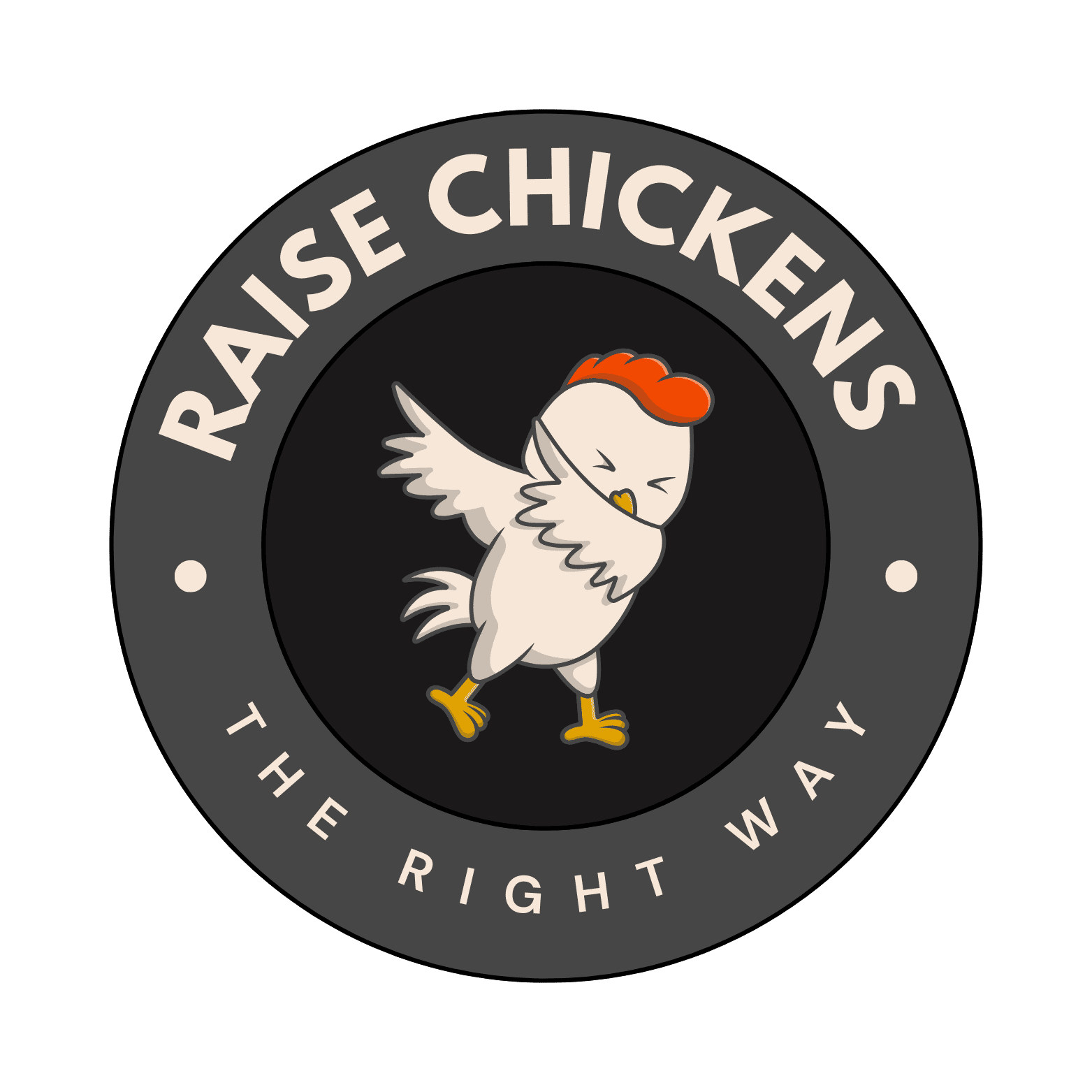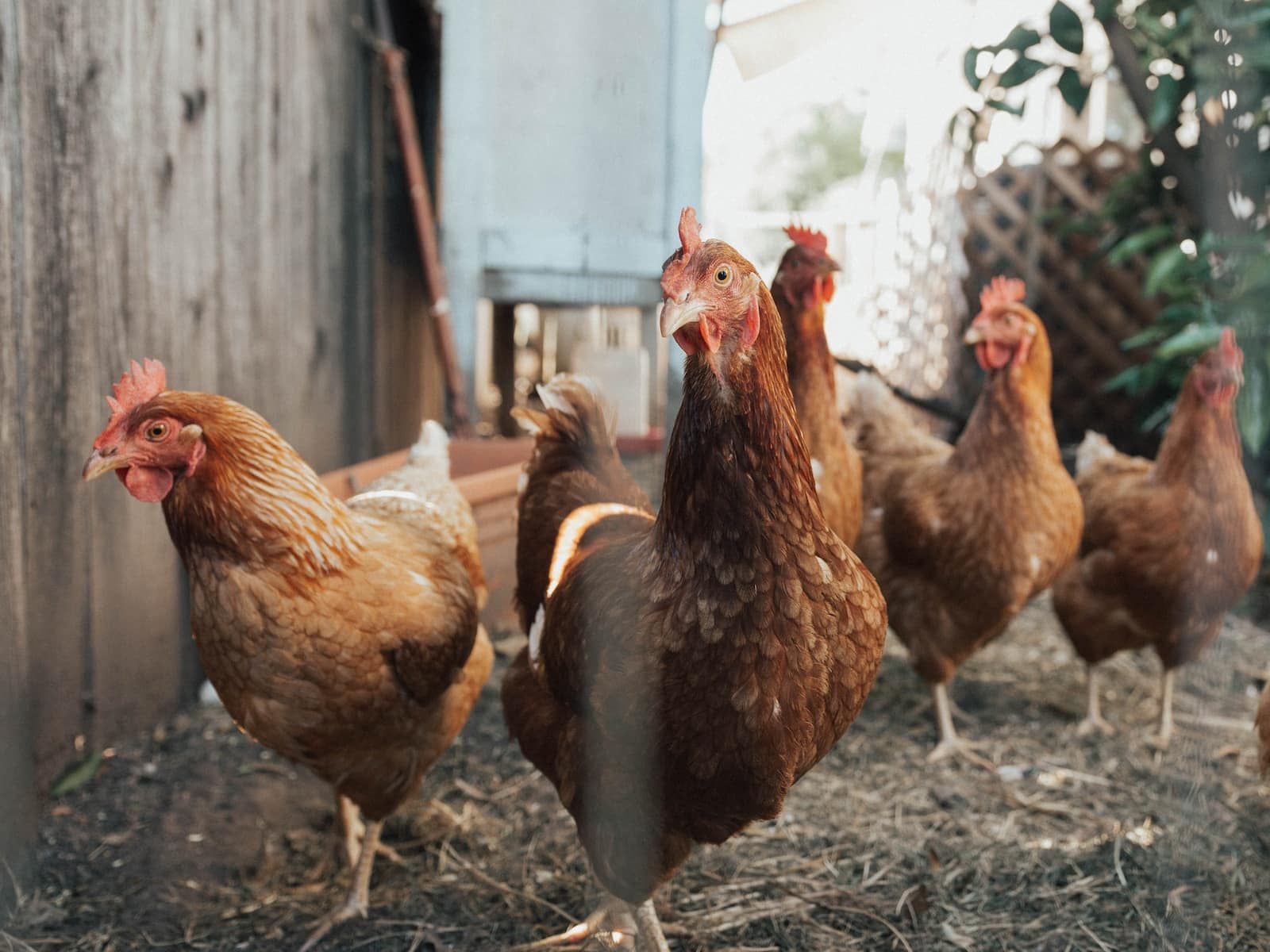
Introduction to Chickens
Chickens are fascinating creatures. If you listen closely on a calm morning, their symphony of clucks and coos will greet you, each sound telling its own tale. These birds have been our allies for centuries, providing us with food, company, and sometimes even a touch of comedy with their antics.
As someone with over 20 years of experience in raising chickens, let me share with you the magic of these wonderful birds and a glimpse into their storied past, anatomy, breeding and more.
Brief history of domesticated chickens
Our journey with chickens began in the dense jungles of Southeast Asia. Wild red junglefowl, the ancestors of modern chickens, roamed these forests, filling the air with their calls. Sometime around 5,000 to 8,000 years ago, our ancestors saw potential in these birds. They began taming and keeping them close, both for their songs and their eggs.
Over time, these tamed junglefowl journeyed with humans, traveling across lands and seas. Every culture they touched adapted and molded them, selecting for specific traits. In Egypt, they were valued for religious ceremonies; in Rome, they were symbols of bravery and were even consulted as oracles!
By the Middle Ages, chickens had become vital to farms across Europe. Their roles were many: they were food providers, pest controllers, and even alarm clocks with their timely morning calls. Different regions began developing their breeds, tailoring them to local needs and climates.
Fast forward to today, and the bond between humans and chickens is as strong as ever. They’ve become an essential part of agriculture worldwide, with breeds as diverse as the places they’ve traveled. From the fluffy Silkies of China to the robust Rhode Island Reds of America, chickens are a testament to human ingenuity and our timeless connection with the natural world.
I hope this gives you a small peek into the rich tapestry of chickens and their history with us. Their journey, from wild birds of the jungle to the heart of our farms, is a story of partnership and mutual growth. And as someone who’s spent a lifetime with them, I can tell you – there’s never a dull moment with chickens around!
Importance of chickens in agriculture and backyard homesteading
Chickens, with their humble clucks and seemingly mundane daily routines, hold a surprisingly significant role in both large-scale agriculture and smaller backyard homesteading setups. They play an important role in our daily routines, and this is how they make our lives better:
- Food Production:
-
- Eggs: One of the most obvious benefits, fresh eggs are a nutrient-rich source of protein. A single hen can lay anywhere from 250 to 300 eggs a year.
- Meat: Chickens, especially certain breeds, are raised for their meat. In many agricultural systems, broiler chickens are a primary meat source due to their quick growth rates.
- Economic Value:
-
- In agricultural settings, chickens can be a significant source of income through the sale of eggs, meat, and even chicks.
- For homesteaders, keeping chickens can substantially reduce grocery bills.
- Pest Control:
-
- Chickens are natural foragers and will happily eat insects, weeds, and even small rodents. This helps in controlling pests naturally, reducing the need for chemical interventions in gardens and fields.
- Soil Fertility:
-
- Chicken manure is a fantastic source of nitrogen, phosphorous, and potassium, essential elements for plant growth. Properly composted, it can be an invaluable organic fertilizer for crops and gardens.
- Their foraging behavior helps in tilling the soil, mixing in organic matter and improving soil structure.
- Sustainability:
-
- Chickens play a role in sustainable and organic farming practices. Their natural behaviors can replace or reduce the need for artificial inputs, like chemical fertilizers or pesticides.
- They can consume kitchen scraps, turning waste into valuable food products (eggs and meat) and reducing a household’s carbon footprint.
- Education and Experience:
-
- For those on a homestead or even in urban settings, raising chickens provides invaluable lessons in responsibility, animal husbandry, and the origins of food. It’s especially educational for children.
- Companionship:
- Beyond their practical benefits, chickens often become beloved pets. Each bird can have its unique personality, and many people find joy in the simple pleasures of watching their flock roam, dust bathe, and interact.
- Cultural and Heritage Preservation:
-
- Raising heritage chicken breeds helps in maintaining genetic diversity. Many older breeds come with storied histories and have traits that are invaluable in terms of disease resistance, adaptability, and unique characteristics.
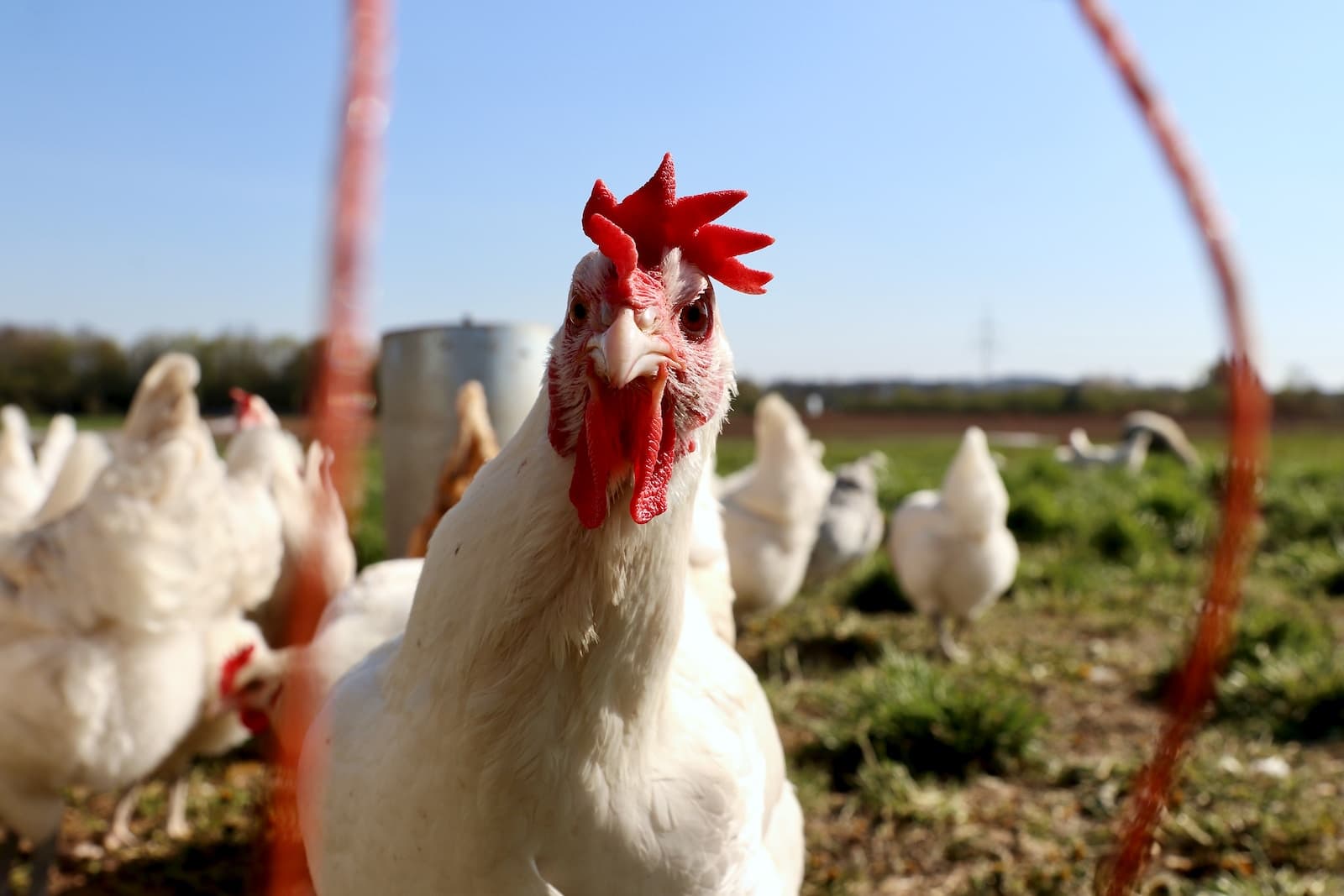
Chickens play a multifaceted role in agriculture and homesteading. They bridge the gap between productive livestock and lovable companions, offering benefits that enhance food security, sustainability, and the quality of life. Whether on vast farms or small backyard plots, chickens prove that sometimes, the most profound impacts come from the most unexpected sources.
Chicken Breeds
With a rich history of domestication and breeding, chickens have diversified into a myriad of breeds, each with its unique characteristics, purposes, and appearances. Let’s delve into some general categories and notable examples:
By Purpose
Egg Layers: Primarily raised for their egg production.
- White Leghorn: Known for its white eggs and consistent laying.
- Rhode Island Red: Brown egg layer, sturdy, and adaptable.
- Australorp: Holds a record for egg-laying and produces brown eggs.
Meat Birds: Raised primarily for their meat.
- Cornish Cross: Fast-growing and meaty, it’s the industry standard for broiler production.
- Jersey Giant: Larger breed developed for meat, but grows slower than the Cornish Cross.
Dual-Purpose: Good for both eggs and meat.
- Plymouth Rock (Barred Rock): Known for its distinctive black and white stripes and well-rounded utility.
- Orpington: Heavy, docile, and comes in various colors like buff and black.
Ornamental: Kept for their unique appearance or for show.
- Silkie: Fluffy, soft plumage with a friendly disposition. They’re also known for their broodiness.
- Polish: Recognizable by its crest of feathers atop its head.
Egg Color
- Ameraucana: Lays blue eggs and has a distinctive “beard” and “muffs.”
- Marans: Produces dark chocolate-colored eggs.
- Olive Egger: Crossbreed that lays olive-green eggs.
By Size
- Standard/Large: These are your typical-sized chickens.
- Bantam: Miniature chickens, often one-fourth to one-fifth the size of their standard counterparts. They come in many breeds, from Bantam Cochins to Bantam Brahmas.
Climate Adaptability
- Chantecler: Developed in Canada and well-suited for cold climates with a small comb to prevent frostbite.
- Fayoumi: Originating from Egypt, this breed is heat-tolerant and very active.
Temperament
- Sussex: Friendly and curious, they’re good for families and can be quite interactive.
- Leghorn: Active and sometimes flighty, they might be less suited to tight confinement.
Heritage vs. Hybrid
- Heritage Breeds: Traditional breeds like the Dominique or Dorking that have been around for centuries and breed true to type.
- Hybrid Breeds: These are crosses between two or more breeds, often developed for specific commercial purposes. Red Star and Black Star are examples known for high egg production.
When choosing a chicken breed, it’s essential to consider what you want from your flock. Whether it’s daily egg production, a meat source, companionship, or simply the joy of having unique-looking birds around, there’s likely a chicken breed that’s just right for your needs. As always, further research into each breed will help in making informed choices tailored to specific environments and goals.
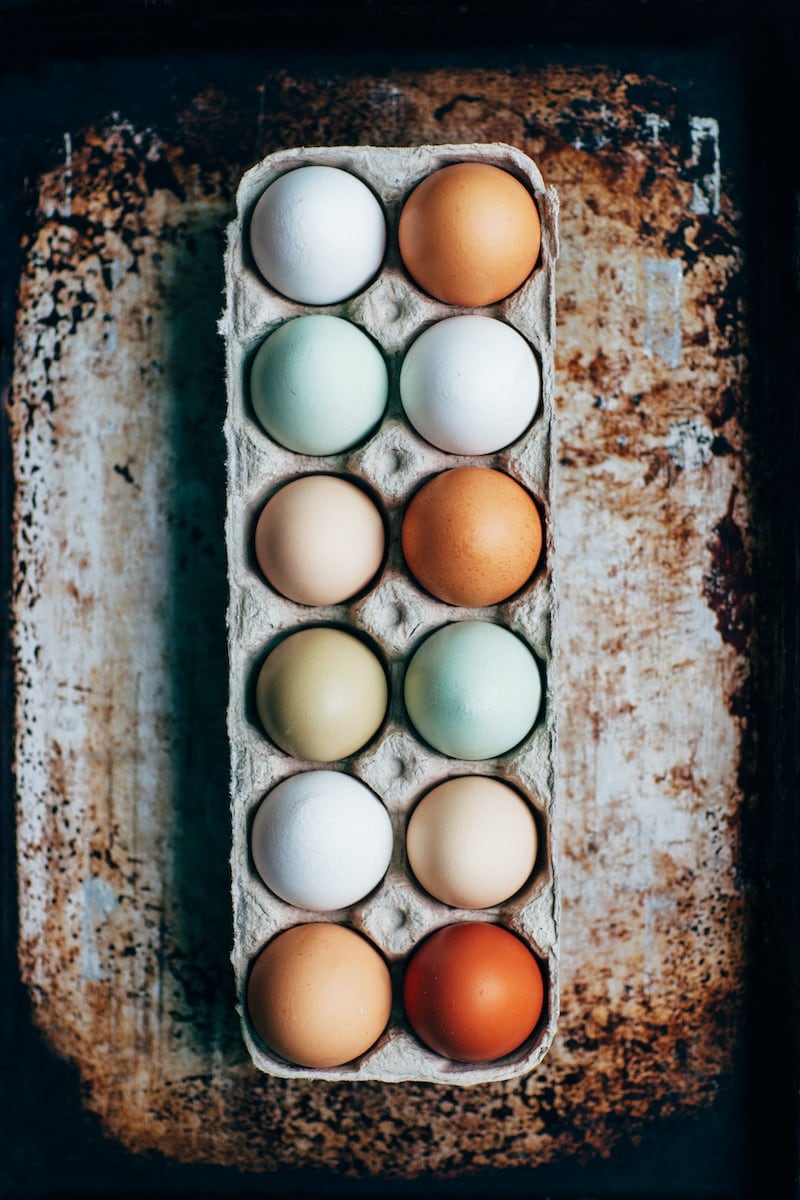
Chicken Anatomy and Physiology
I firmly believe that every farmer and individual raising chickens should have a solid understanding of their anatomy and physiology. This knowledge is fundamental to ensuring the well-being and optimal care of these birds. Here’s my simple overview:
External Anatomy
- Comb: The fleshy, often red, protrusion on top of the head. It aids in thermoregulation.
- Wattles: The dangling fleshy parts under the chin/beak. Like the comb, they assist in heat regulation.
- Beak: Used for eating, drinking, and exploring. Chickens don’t have teeth, so they peck and swallow food whole.
- Eyes: Chickens have a broad visual spectrum and can even see ultraviolet light.
- Ears: Chickens have internal ears covered by earlobes, which can be white, blue, or red. Interestingly, earlobe color often correlates with eggshell color.
- Feathers: Offer protection and insulation. They also play roles in mating displays and establishing pecking order.
- Wings: Though most chickens are not adept fliers, wings assist in short flights, balance, and body language.
- Tail: Comprises feathers that aid in balance and displays.
Skeletal System
Chickens have a lightweight skeleton, with many bones fused for added strength.
The keel bone is an extension of the breastbone and provides an anchor for the bird’s flight muscles.
Respiratory System
Chickens have a unique respiratory system. They possess air sacs that allow for a continuous flow of air through the lungs, both during inhalation and exhalation.
This system makes them efficient oxygen extractors but also more susceptible to respiratory dust and toxins.
Digestive System
- Crop: A storage area where food is softened.
- Gizzard: A muscular part of the stomach that grinds food using small stones that chickens consume.
- Liver and Pancreas: Produce enzymes and bile essential for digestion.
- Intestines: Nutrient absorption occurs here.
Reproductive System
Hens have one functional ovary, typically the left, which releases yolks. As the yolk travels down the oviduct, it accumulates layers, forming a complete egg.
Roosters have two testes internally, producing sperm that can fertilize the hen’s eggs.
Circulatory System
Chickens have a four-chambered heart. Their body temperature is naturally higher than that of humans, averaging around 105°F (40.5°C).
Excretory System
Chickens don’t urinate in the way mammals do. Instead, they excrete uric acid along with feces. This results in the white and brown components seen in their droppings.
Nervous System
Chickens have a brain that controls vital functions and behaviors. They exhibit various emotions and have demonstrated problem-solving abilities.
The pineal gland in their brain helps in sensing light changes, crucial for laying patterns.
Endocrine System
A series of glands, like the pituitary and thyroid, produce hormones that regulate growth, reproduction, and more.
Understanding the anatomy and physiology of chickens aids in recognizing when they’re in optimal health and when they might be experiencing challenges. It allows keepers to cater to their needs more effectively and appreciate the intricate wonders of these common, yet extraordinary birds.
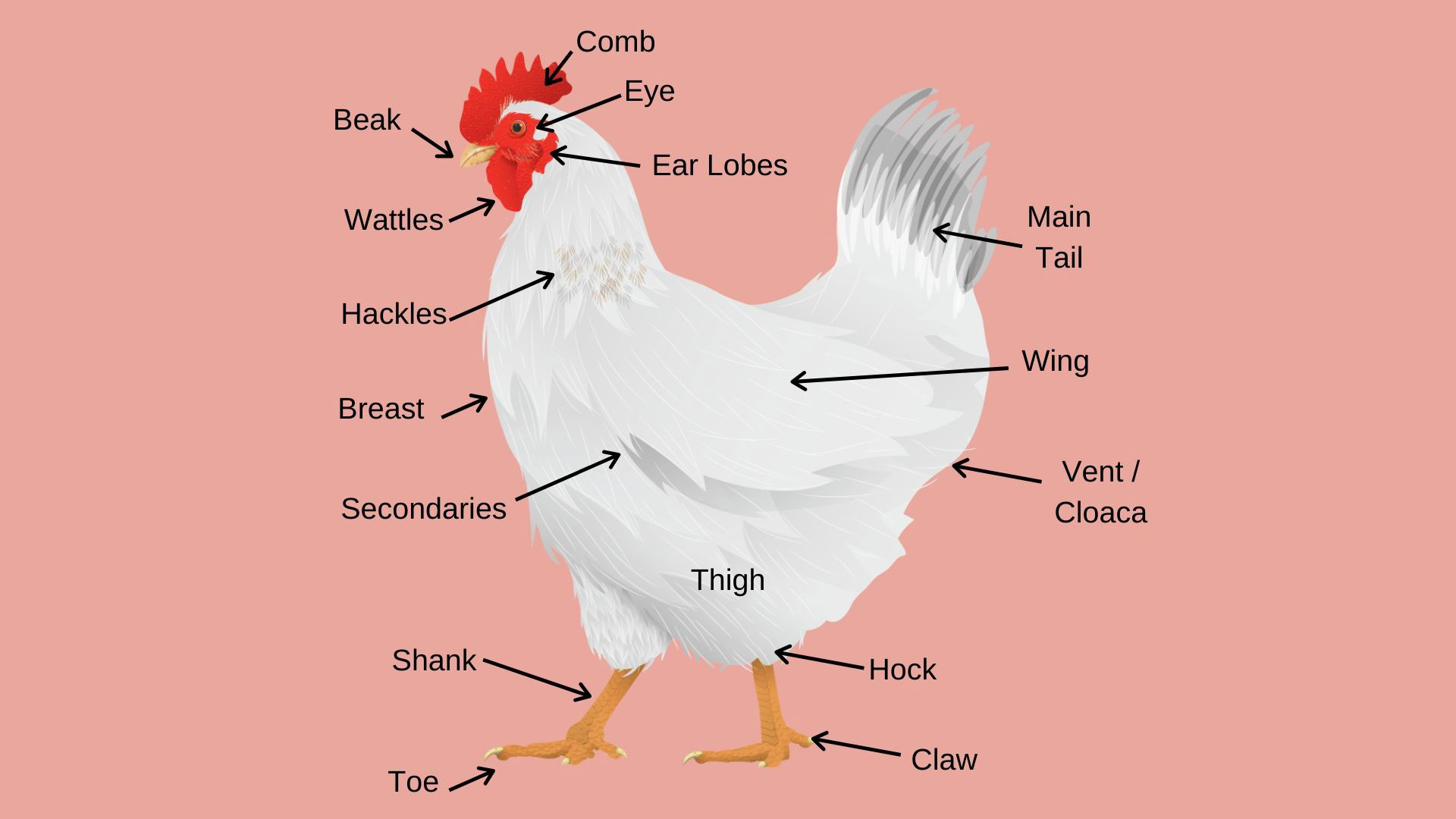
Housing and Coop Design
Providing proper housing is crucial for the health, safety, and productivity of your chickens. Here’s what to consider:
Location
Place the coop in a well-drained area to prevent moisture buildup, which can lead to diseases.
Ensure the coop receives natural sunlight but also has shaded areas for hot days.
Size
A general rule of thumb is to allocate at least 2-3 square feet per bird inside the coop. However, more space is always better. For the outdoor run, provide a minimum of 8-10 square feet per chicken.
Ventilation
Good airflow is essential to keep the coop free from moisture, ammonia buildup, and respiratory problems. Ensure vents are placed above roosting height so there are no drafts directly on the birds.
Roosting Bars
Chickens prefer to sleep off the ground. Provide roosting bars, ideally 2-4 feet off the ground, with at least 8-12 inches of space per bird.
Nesting Boxes
For egg-laying hens, ensure you provide nesting boxes. A good ratio is one box for every 4-5 hens.
Nesting boxes should be cozy, measuring around 12×12 inches, and located in a dark, quiet area of the coop.
Protection
Use hardware cloth (a type of wire mesh) instead of chicken wire for enclosures. It’s more robust and protects against predators.
Bury the wire at least 12 inches into the ground around the perimeter to deter digging predators.
Flooring
Dirt, concrete, wood, or linoleum all work, but each has pros and cons. For instance, wood can absorb droppings but may decay over time, while concrete is easy to clean but can be cold in winter.
Cover the floor with a bedding material, like straw or wood shavings, to absorb droppings and moisture.
Accessibility
Design the coop so it’s easy for you to enter, clean, and collect eggs. Consider hinged roofs or doors for easy access.
Weather Protection
Ensure the coop protects against rain, wind, and extreme temperatures. In colder climates, insulate the coop but avoid using heat lamps, which can be a fire hazard.
Food and Water
Provide continuous access to fresh water and feed. Use hanging feeders and nipple or cup waterers to keep food and water clean.
Some expert housing tips
-
- Add sand or pebbles: Consider adding sand or pebble areas for dust baths, which chickens use to maintain feather health.
- Add enrichment: Providing perches, ladders, and other enrichments can also enhance the chickens’ environment.
- Try the deep litter method: This is a method where you allow bedding material and chicken droppings to accumulate and decompose naturally over time. When managed correctly, it generates heat in the winter and requires cleaning only once or twice a year. Moreover, it can be a fantastic compost for gardens.
- Elevate the coop: Raising the coop a few feet off the ground can deter pests and rodents. Plus, the space underneath can serve as a sheltered area for chickens to rest during hot or rainy days.
- Dropping boards: Placing a board or tray beneath roosting bars can make cleaning easier. Chickens tend to defecate most during the night, so this setup allows you to simply scrape off the droppings daily, keeping the coop fresher.
- Automatic doors: Installing automatic coop doors can be a game-changer. They can be timed to open at dawn and close at dusk, ensuring chickens are secured at night without you having to be there.
- Observation window: Installing a small window allows you to quickly check on your flock without disturbing them, especially during nesting or brooding periods.
- Herbs in the nesting box: Certain herbs, like lavender, mint, and marigold, can deter pests and keep the nesting area smelling fresh. Plus, many believe they have calming effects on hens.
- Predator-proofing: Install motion-activated lights or even solar-powered predator deterrents to keep nocturnal predators at bay. Consider a double-door system: an outer door and a mesh inner door. This can prevent a chicken from rushing out and deters predators from gaining easy access.
- Water management: In cold climates, invest in a heated waterer to prevent freezing. In hot climates, ensure shade over water sources and consider adding electrolytes or vitamins to the water during extreme heat.
A well-designed coop caters to the natural behaviors of chickens while ensuring their safety and well-being. Whether you’re building from scratch or adapting a pre-made structure, always prioritize the needs and health of your flock.
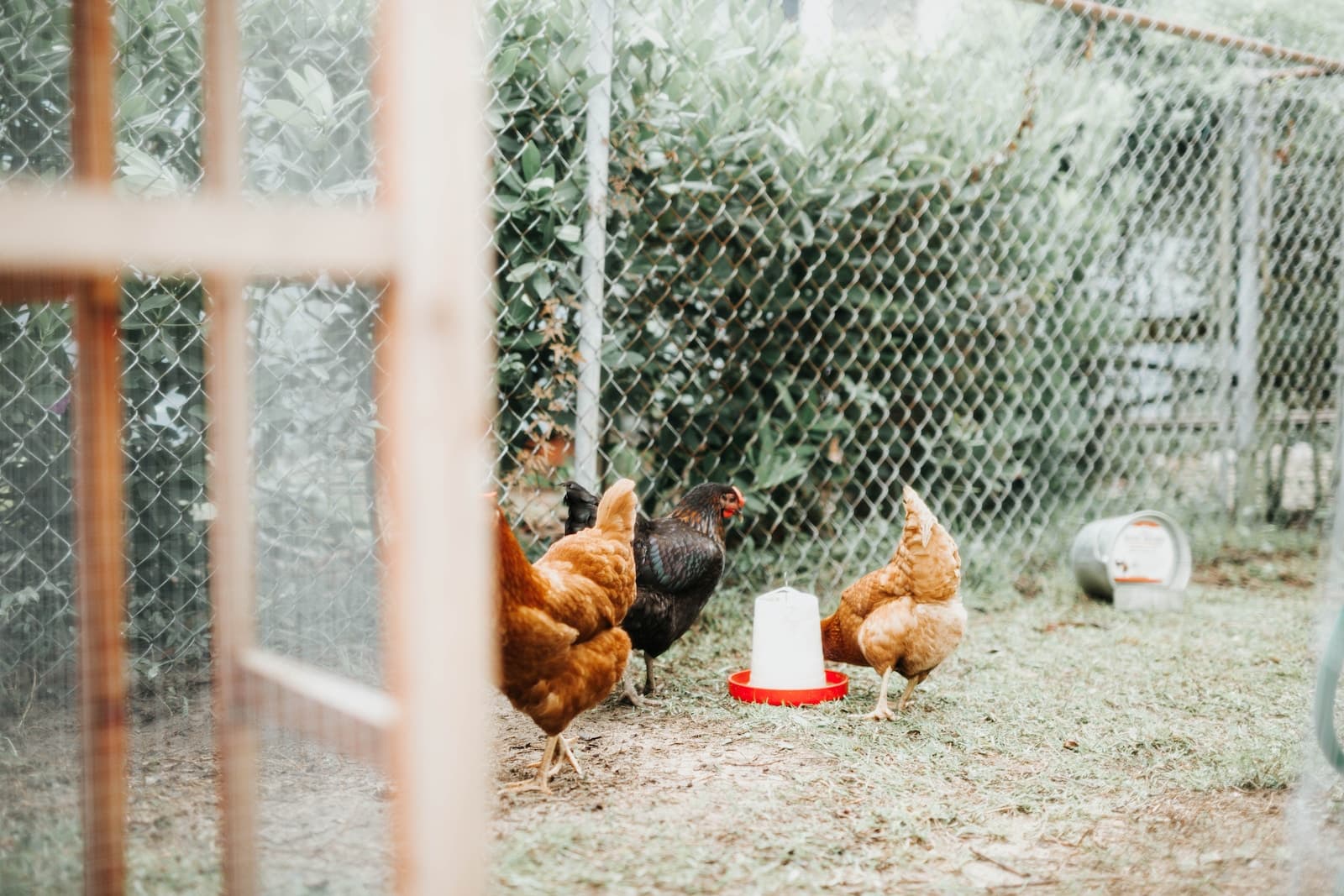
Feeding and Nutrition
Proper feeding and nutrition form the cornerstone of poultry health and productivity. A well-fed chicken is a happy, productive chicken, and understanding their dietary needs is vital for any poultry keeper.
Chickens’ dietary requirements vary according to their life stage, purpose (e.g., meat production, egg laying, or pet), and health status.
Stages and Specific Diets
Chicks start their life with a “starter feed.” This feed has higher protein content, usually around 20-24%, and it’s designed to support rapid growth. They’ll be on this diet for the first 6-8 weeks.
As the chickens grow, transitioning to a “grower feed” becomes essential. This typically has slightly less protein, around 18-20%, and is given until they approach laying age, if they’re being raised for eggs.
Layers, once they start producing eggs (around 18-22 weeks of age), need a “layer feed.” This diet is enriched with calcium, necessary for strong eggshells. The protein content is usually around 16-18%.
For broilers or chickens raised for meat, there’s a specific feed formulation aimed at maximizing growth, often with higher protein and energy content.
Understanding Nutritional Needs
Carbohydrates provide energy. Corn is a typical source in many feeds, giving the yellowish tint to yolks in many commercial eggs.
Proteins are vital for growth, feather formation, and overall health. Common sources in poultry feed include soybean meal and fish meal.
Fats add energy to the diet. They also carry essential fat-soluble vitamins like A, D, E, and K.
Minerals like calcium and phosphorus are critical, especially for layers. Calcium is crucial for strong eggshells, while phosphorus is necessary for skeletal health and metabolic processes.
Vitamins are also essential. A deficiency in any of the critical vitamins can lead to health issues. For example, a lack of vitamin A can affect vision, while vitamin D deficiency can cause rickets.
Water is often overlooked but is an essential nutrient. Chickens need a constant supply of fresh, clean water. Their intake can be surprisingly high, especially in hot weather or when they’re producing eggs.
Supplementing and Treats
While commercial feeds are formulated to provide a balanced diet, many keepers like to offer supplements or treats.
Common treats include grains like oats or barley, fruits, vegetables, and even mealworms. However, it’s essential to ensure treats and supplements don’t make up more than 10% of their overall diet to maintain nutritional balance.
Grit is another important addition if chickens aren’t free-ranging. It aids in digestion by helping the gizzard grind down food.
Potential Issues and Considerations
Overfeeding or underfeeding can lead to health issues. Obese chickens might have reduced egg production and can suffer from various health ailments. Conversely, undernourished chickens are more susceptible to diseases and will have reduced productivity.
It’s also important to be aware of foods that are toxic to chickens, such as chocolate, dried or raw beans, and avocado.
Understanding and meeting the nutritional needs of your chickens is a dynamic task that requires attention to detail, observation, and a willingness to adapt based on the chickens’ growth, health, and production needs. With the right diet, you can ensure your flock thrives and rewards you with good health, eggs, or meat.
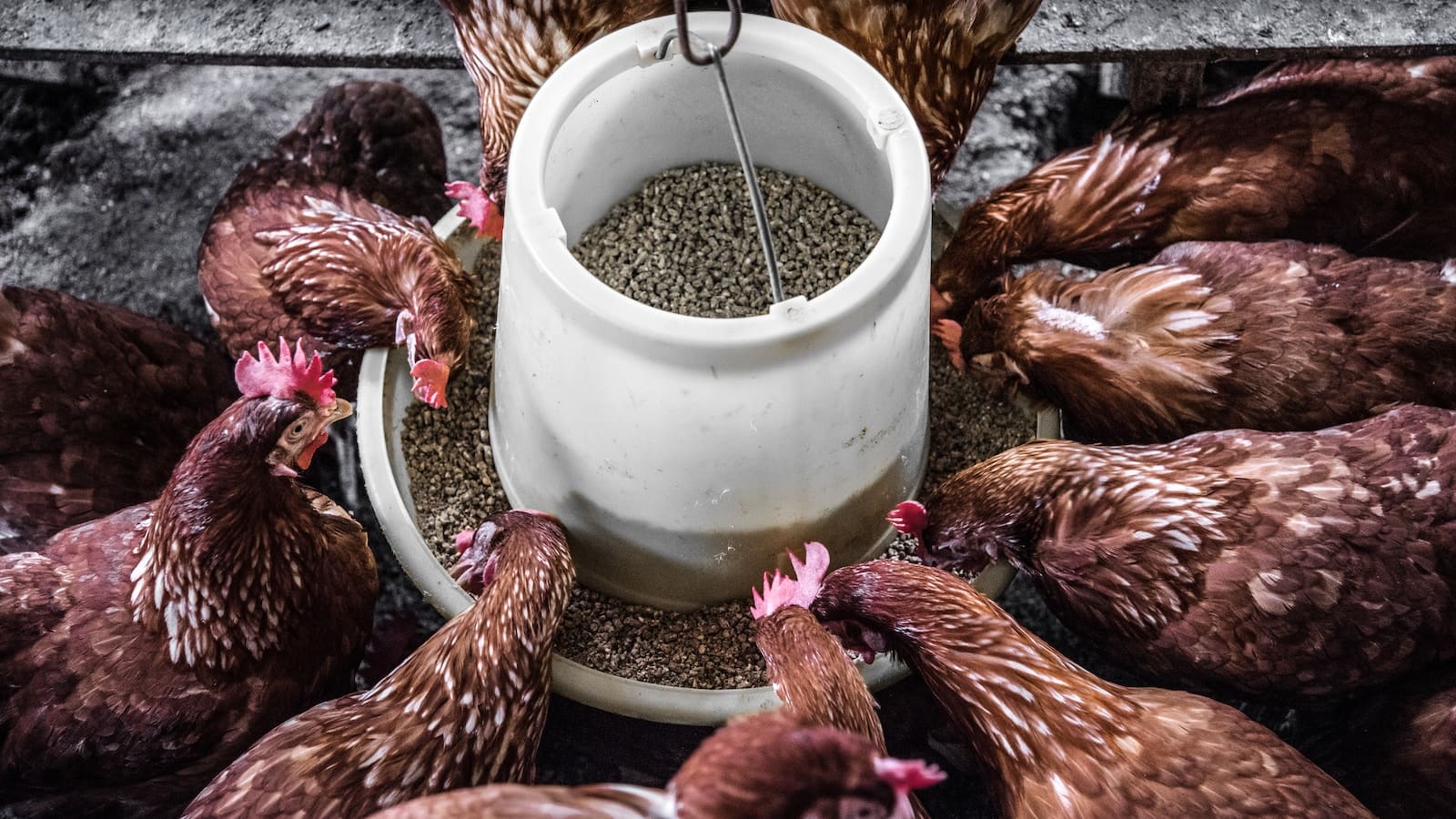
Health and Disease
Maintaining the health of your chickens is of paramount importance, not just for their well-being but also for the safety of the eggs and meat they produce. A thorough understanding of common ailments and preventive measures is crucial for every poultry keeper.
Observing for Signs of Illness
A healthy chicken is active with bright eyes, a red comb, and wattle, and displays consistent eating and drinking habits. Any deviation from their regular behavior can be a sign of potential illness.
Signs of a sick chicken might include lethargy, decreased appetite, irregular droppings, limping, difficulty breathing, or a drop in egg production.
Common Ailments and Diseases
- Marek’s Disease: A viral disease that affects the nervous system. Symptoms might include paralysis, irregularly shaped pupils, and tumors. Vaccination is available and recommended for chicks.
- Coccidiosis: Caused by a protozoan parasite, it’s common in young birds. Symptoms include blood in droppings, lethargy, and loss of appetite. It’s best prevented with good hygiene and can be treated with medicated feeds or specific anti-coccidial drugs.
- Bird Flu: A highly contagious viral disease with symptoms ranging from respiratory issues to sudden death. Strict biosecurity measures are essential to prevent its spread.
- Infectious Bronchitis: A respiratory disease with symptoms like coughing, sneezing, and nasal discharge. Vaccination is the primary preventive measure.
- External Parasites: Lice and mites are common external parasites. They can lead to discomfort, feather loss, and decreased egg production. Regular checks and appropriate treatments are necessary.
- Internal Parasites: Worms can infest the digestive system. Regular de-worming, based on veterinarian advice, can help manage this issue.
- Egg Binding: A condition where a hen is unable to lay an egg. It can be caused by various reasons, including nutritional imbalances or age.
Preventive Measures
- Biosecurity: Limiting the introduction of new birds and having a quarantine period can help prevent the spread of diseases. Regularly disinfect boots, tools, and equipment.
- Vaccination: Vaccinating your flock against prevalent diseases is a proactive measure.
- Regular Health Checks: Regularly handling and examining your birds can help catch symptoms early on.
- Cleanliness: Ensuring the coop, feeders, and waterers are clean can prevent many diseases.
- Access to Fresh Water and Nutritious Food: A balanced diet and clean water boost the immune system, keeping diseases at bay.
- Stress Reduction: Minimizing stress, through consistent routines and avoiding overcrowding, can reduce susceptibility to diseases.
Handling Sick Chickens
Isolate any sick bird immediately to prevent the potential spread of diseases. Seek advice from a veterinarian, especially if you’re unsure about the illness or how to treat it.
Remember, some diseases can spread to humans, so always practice good hygiene, wearing gloves and washing hands thoroughly after handling sick birds.
While chickens are relatively robust animals, they aren’t immune to health issues. Being informed and observant, combined with proactive management practices, will go a long way in ensuring your flock remains healthy and productive.
Egg Production
Starting the Journey
A hen’s journey to lay eggs begins well before the first shell is formed. By the time she is born, a female chick already carries all the egg yolks she will ever lay. As she matures, hormonal changes and external factors, such as light exposure, will determine when she starts laying.
Age and Productivity
The onset of egg laying usually begins around 18 to 22 weeks of age, depending on the breed and environmental conditions. The most productive period of a hen’s life is the first year of laying, where many breeds can produce anywhere from 250 to 300 eggs per year. However, after this period, there is a gradual decline in production.
The Role of Daylight
Daylight plays a significant role in egg production. Hens require about 12 to 14 hours of daylight to maintain consistent laying. This is why many commercial operations and some backyard poultry keepers use artificial lighting during shorter days to stimulate production.
The Egg Formation Process
The process of forming an egg is intricate and takes about 24 to 26 hours. Once an egg is laid, the cycle begins again within a half hour. The color of the eggshell is determined by the breed of the chicken; for instance, White Leghorns lay white eggs, while Rhode Island Reds lay brown eggs. Interestingly, the earlobe color of a chicken can often predict the color of the eggs they’ll lay, though there are exceptions.
Nutrition’s Crucial Role
Nutrition plays a pivotal role in egg production. Layers need a balanced diet rich in calcium for strong eggshells. A deficiency in certain nutrients can lead to various egg abnormalities like soft-shelled eggs, misshapen eggs, or eggs with irregular coloring. Access to clean water is equally vital, as a significant portion of the egg is water.
Factors Influencing Egg Production
Egg-laying can be influenced by several factors besides light and nutrition. Stress, whether from predators, disease, or environmental changes, can reduce or halt egg production. Similarly, molting, the process where chickens shed and regrow feathers, often sees a temporary cessation in laying.
Molting typically occurs annually and can result in a temporary decrease or cessation in egg production. During molting, chickens may appear ragged and bare in spots, but over time, they’ll regain a full, new plumage, which helps maintain their body temperature and protection against environmental elements.
The Importance of Collection
Collecting eggs regularly is essential. Not only does this ensure the freshness of the eggs, but it also reduces the chances of hens becoming broody, a state where they wish to hatch their eggs and may stop laying. It’s also crucial to provide a comfortable and secluded nesting space for hens to lay; this encourages egg-laying and reduces the risk of egg breakage.
While the act of a chicken laying an egg might seem simple, it’s a culmination of various biological and environmental factors working in harmony. For those raising chickens, understanding these nuances can make the difference between a sporadic egg supply and a consistent basketful of fresh eggs.
Breeding and Broodiness
Basics of Chicken Reproduction
Chicken reproduction commences with the act of mating, where a rooster fertilizes the eggs of a hen. Once fertilized, these eggs, if provided with the right conditions, will develop and hatch into chicks.
Typically, the entire process demands a consistent environment, primarily in terms of temperature and humidity, to ensure healthy development of the embryo within the egg.
Selecting and Breeding for Specific Traits
Breeding chickens is a blend of science and observation, used to produce the next generation of poultry.
Through selective breeding, many diverse chicken breeds have been developed, each with its unique attributes. These attributes can range from physical characteristics like size and color to behavioral traits such as temperament and laying patterns.
By carefully selecting which chickens to mate, poultry keepers can emphasize specific desired traits in the offspring.
Recognizing and Managing Broody Hens
Broodiness is a natural behavioral state where a hen feels a strong instinctual drive to hatch her eggs. A broody hen is easily recognizable as she will consistently sit on her clutch, only leaving briefly for essential activities.
When approached, she might puff up and emit a distinct clucking sound as a sign of protection. Depending on the goals of the chicken keeper, broodiness can either be encouraged or disrupted. If the intent is not to hatch chicks, breaking the broodiness can get the hen back to her regular laying routine.
This can be achieved by methods like isolating the hen from the nesting box or employing a wire-bottomed cage to minimize the warmth she feels.
Incubation and Hatching Basics
For an egg to successfully hatch, it requires an environment with a temperature of around 37.5°C (99.5°F) and relative humidity between 50-60%. This precise condition ensures the healthy growth of the embryo inside.
While a broody hen can naturally provide these conditions, artificial incubators are also commonly used, especially when hatching large batches of eggs. Whether using a hen or an incubator, the eggs need to be occasionally turned to promote even development. After about 21 days under these consistent conditions, the chicks will begin to hatch, marking the end of the incubation period and the start of a new life.
Handling and Behavior
Proper Techniques for Catching and Holding Chickens
Handling chickens properly ensures their safety, reduces stress, and minimizes the risk of injury to both the bird and the handler. When attempting to catch a chicken, it’s best to approach calmly and quietly, preferably from the side or behind.
Once near, you can gently but firmly hold the chicken by placing one hand on its back and the other beneath its breast, securing the wings against the body. This method prevents flapping and potential harm.
For larger chickens or roosters, it’s often helpful to hold the bird’s legs as well, which provides added control. Always lift and carry the bird close to your body to offer security and reduce the chances of it struggling.
Social Structure: Pecking Order
Chickens exhibit a fascinating social structure commonly referred to as the “pecking order.” This hierarchical system determines which birds have dominance over others, affecting everything from access to food and water to preferred roosting spots.
At the top are the dominant birds, which often eat first and can assert their authority by pecking or chasing others. At the bottom, more submissive birds may wait their turn or move out of the way of the more dominant flock members.
Establishing the pecking order can sometimes involve mild squabbles, but once established, it helps maintain order and reduce serious conflicts within the flock.
Common Behaviors and Their Meanings
Chickens exhibit a range of behaviors, each conveying specific intentions or states of being:
- Dust Bathing: Chickens often create small depressions in the ground, fluff up, and roll around in dust or sand. This behavior helps to keep their feathers clean, reduce parasites, and provides a form of relaxation.
- Clucking: A steady stream of low clucks usually signifies contentment, especially if the chicken is foraging.
- Broody Growls and Squawks: When a hen is broody and someone approaches her nest or tries to touch her, she might produce a low growling sound or a louder squawk, indicating her protective state.
- Rooster’s Crow: While most recognize it as a way to herald the dawn, roosters will crow throughout the day. This behavior serves multiple purposes: establishing territory, signaling to hens, or responding to perceived threats.
- Feather Pecking: It’s an action where a chicken pecks at the feathers of another. While light pecking is normal and part of establishing the pecking order, aggressive feather pecking can be a sign of stress, boredom, or nutritional deficiencies.
Understanding these behaviors and recognizing their nuances will allow poultry keepers to respond more effectively to the needs of their flock and ensure a harmonious and productive environment.
Ethical Considerations
Humane Treatment of Chickens
Ensuring the humane treatment of chickens is at the core of ethical poultry keeping. This involves providing them with suitable living conditions, which include adequate shelter, space to roam and forage, access to clean water and nutritious food, and protection from predators. Chickens should also be kept in a stress-free environment, free from unnecessary disturbances. Regular health check-ups, prompt medical attention, and engaging enrichment activities like perches, dust baths, and diverse foraging opportunities contribute to their well-being and overall quality of life.
Considerations for Culling and End-of-Life Decisions
Culling, the process of removing unproductive or sick birds from a flock, is an inevitable aspect of poultry keeping. Ethical considerations dictate that any culling should be carried out as humanely and painlessly as possible. Decisions to cull should be based on the health, well-being, and quality of life of the bird. In cases where a bird is suffering and cannot be treated, euthanasia may be the most compassionate choice. It’s essential for poultry keepers to be educated about humane methods and to approach these decisions with empathy and responsibility.
Sourcing Chickens: Hatcheries vs. Rescues
Where one sources their chickens can also be an ethical decision. Hatcheries offer a wide variety of breeds, and many adhere to rigorous health and safety standards. However, some criticisms arise due to practices like the culling of male chicks in layers’ production or the potential for overbreeding.
On the other hand, rescuing chickens from shelters or from situations of neglect provides a second chance to birds in need. Rescued chickens might have special needs or bear the scars of past trauma, but with proper care, they can thrive and become productive members of a new flock.
Resources and Tools
Books
- “The Chicken Health Handbook” by Gail Damerow: This comprehensive guide covers various aspects of chicken health, including disease prevention, diagnosis, and treatment.
- “Storey’s Guide to Raising Chickens” by Gail Damerow: An invaluable resource for both beginners and experienced poultry keepers, this book provides in-depth information on breed selection, feeding, housing, and more.
- “The Small-Scale Poultry Flock” by Harvey Ussery: A holistic approach to raising poultry, focusing on sustainable and organic practices.
- “Hatching & Brooding Your Own Chicks” by Gail Damerow: A guide that covers everything from incubating eggs to raising chicks.
- “The Chicken Encyclopedia” by Gail Damerow: An illustrated A-to-Z reference packed with entries on various chicken-related topics.
Websites
- BackYard Chickens (BYC): A comprehensive website with forums, articles, reviews, and a vast community of poultry enthusiasts ready to share advice and experiences.
- The Poultry Site: This site offers a mix of news, articles, and resources on poultry health, welfare, and management.
- Poultry Keeper: A UK-based site offering articles, advice, and forums on various poultry species, not just chickens.
- Chicken Vet: Associated with the UK’s only dedicated poultry veterinary service, this site provides resources on health and disease topics.
- Meyer Hatchery: While primarily an online store, Meyer Hatchery’s site also contains a valuable blog with advice on poultry care, breed selection, and more.
American local poultry associations and clubs
The United States boasts a rich and diverse community of poultry enthusiasts. Here are ten top local poultry associations and clubs that cater to a range of interests from show birds to backyard flocks:
- American Poultry Association (APA): Founded in 1873, the APA is one of the oldest poultry organizations in North America. They’re responsible for the “Standard of Perfection,” a comprehensive breed guide.
- United Poultry Fanciers (UPF): A dedicated group that organizes and promotes poultry shows, UPF often collaborates with the APA for various events.
- National Poultry Improvement Plan (NPIP): While not a traditional club, NPIP is a national collaboration of state agencies that monitor and improve the health of the nation’s poultry.
- American Bantam Association (ABA): Focusing on bantam breeds, the ABA is a dedicated association that promotes these miniaturized birds through shows, publications, and events.
- The Livestock Conservancy: While they cover all livestock, they have a significant focus on preserving and promoting heritage poultry breeds.
- American Pastured Poultry Producers’ Association (APPPA): This association promotes and supports the practice of raising poultry on pasture.
- American Silkie Bantam Club: As the name suggests, this club is for enthusiasts of the fluffy Silkie bantam.
- Rare Poultry Breeders’ Association: Dedicated to the promotion and preservation of rare and heritage poultry breeds.
- Society for the Preservation of Poultry Antiquities (SPPA): Focused on very old, traditional poultry breeds and practices.
- North American Game Bird Association (NAGBA): While more focused on game birds, they offer resources and connections for those interested in raising game poultry like quail, pheasant, and others.
